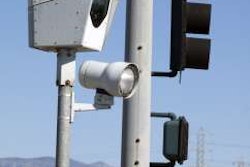
By Lauren Heartsill Dowdle, Contributing Editor
When you work road construction zones there is never really a time to relax when it comes to safety. The job, more or less cordoned off from an ever-present public, demands safety awareness and so do the passing drivers. But when work halts, traffic doesn’t.
Each year, more than 20,000 workers are injured in road construction work zones, with 106 fatalities in 2010, according to the Federal Highway Administration (FHWA). Causes include (from most to least common) contact with objects or equipment; slips, trips or falls; overexertion, transportation incidents and exposure to harmful substances or environments.
Having jobs next to the motoring public is becoming even more common because a large portion of road projects are reconstruction, instead of new construction, putting crews on the sides and medians of busy streets and highways.
“When it’s a project that’s under traffic, crews need to take extra concern,” says Brian Turmail, executive director of public affairs, Associated General Contractors of America (AGC). “Being aware of cars driving in and out of the work zone can be a challenging situation for workers – making it important for the crews to know the speed limits around them.”
And if the constrained work area and extra element of dealing with cars doesn’t add enough pressure, the ever-present need to do more in less time constantly is in the front of everyone’s mind. To squeeze more into the workday, many crews are operating into and through the night to finish projects, which can limit visibility for them and drivers.
“It’s a balance,” Turmail says. “Safety should always come first – even though there’s a real emphasis on getting the jobs done quicker, which can bring up safety concerns.”
While most workers would know to enclose the work area with cones and put on reflective vests, there are some often-overlooked or downplayed situations that could quickly lead to injuries or fatalities on the jobsite. Here are six of those safety concerns to remember in road construction zones.
1 Don’t Stand Behind Trucks
A staple on road-construction project sites is the working truck. The traffic-control truck is especially common for Sterndahl Enterprises in Sun Valley, California. This full-service striping, stripe-removal and traffic-control company mostly works on reconstruction projects, making traffic safety a top concern, says Dennis “Chip” Sterndahl, president of Sterndahl Enterprises (www.sterndahl.com) and former president of the American Traffic Safety Services Association (ATSSA).
The acceptable processes, procedures, equipment and how his crews set up the equipment have evolved and improved in the past few years, Sterndahl says. One change they have made to minimize the possibility of injury is where the workers stand when they are near traffic-control equipment.
“History has shown many instances of employees picking up lane-closure signs who have been hit while standing at the back of the equipment,” Sterndahl says. “We try to avoid this by having workers stand to the side of the truck.”
The company welded the rear gates closed so no one can get the equipment off the truck from the back.
The National Institute for Occupational Safety and Health (NIOSH) reports 51 percent of worker-on-foot fatalities that occurred within a highway work zone involved backing vehicles, according to a federal government report. Emerging technologies in the field of operations include after-market devices, such as cameras and proximity detection systems. The use of spotters and internal traffic control plans can also make backing operations safer. Struck-by injuries and caught between injuries are two of the four leading causes of workplace fatalities. OSHA Integrated Management Information System (IMIS) data indicates that, between 2005 and 2010, more than 350 workers died as a result of backing incidents. While these incidents can be fatal, workers can also suffer severe, non-fatal injuries. A review of OSHA’s IMIS database found that backing incidents can result in serious injury to the back and pelvis, fractured bones, concussion, amputation and other injuries.
2 Don’t Be Complacent
On a jobsite that requires a rigid attention to detail, sometimes the simplest – and most important – safety practices can go overlooked. Many times, road crews forget to go back to the basics and become too comfortable when working around traffic.
“Something I commonly share in safety meetings – and perhaps the best advice – is to always use caution,” Sterndahl says. “Employees who have worked around high-speed traffic for many years almost get immune to it. This can create a dangerous situation if they become so used to it that they don’t practice caution.”
One way to counteract this complacency is for the jobsite managers to talk to their crews and prepare them for each jobsite and the dangers they could encounter.
Sterndahl has tailgate safety meetings specific to each jobsite, and they have companywide monthly safety meetings. New employees also receive jobsite and classroom training. “It creates a mindset in the new employee that they have an obligation to learn,” Sterndahl says. “By design, we’ve minimized the number of work-place injuries.”
Another factor in avoiding numbness to the job is for crews to remember where they are and to keep a watchful eye on the passing cars. Although it may sound simple, many accidents go back to this advice, Turmail says. “Beware of distracted drivers,” he says. “They’re dangerous anywhere, but when it comes to a work zone, they are even more dangerous.”
3 Barriers, Not Chairs
Often referred to as Jersey bumps, walls or k-rails, concrete barriers can be an effective way of separating workers from motorists or for re-routing traffic.
Sterndahl’s team has expanded their use of these fixed barriers wherever possible, and he urges others to do the same. “If the DOT will allow it, use more Jersey walls to keep traffic out of the work zone,” he says.
These sturdy dividers help direct drivers, and the same should be true for the crews. However, in some reported cases, workers have viewed these barriers as a place to relax, which can be a fatal mistake.
Sterndahl says he has heard of employees sitting on the protective barriers between the work area and traffic on their break. “That’s a classic mistake you wouldn’t your employees to make,” he says.
To help the barriers stand out even more along roadways, and serve as a reminder that they are not chairs, road crews can paint them a color that stands out from the background or install reflectors, lights or light tubes. These barriers can be effectively used in conjunction with other traffic-control devices such as warning signs to prevent drivers from getting too close.
4 Keep Communication Lines Open
If a rogue vehicle were to make its way into the work zone, it could obviously do a lot of damage and cause serious injuries. How information about ‘rogue’ dangers is relayed to the crew could save lives.
Sterndahl Enterprises installed two-way radios in their on- and off-highway vehicles for cases such as this one. “Having the two-way radios on the jobsite is critical,” he says. “It helps in the event that you need an early warning system. If a car breaches a lane closure, we can give everyone the heads up.”
On any road construction site, noise can make hearing and verbal communication difficult and at times impossible. If the jobsite equipment does not have radios, hand signals can help convey a command to an equipment operator and serve as a reminder of the workers whereabouts.
But lessons learned show that hand signals must be simple and clear and understood by everyone working the job.
5 Make Positive Contact
Equipment can be a major contributor to work-zone hazards. Add the extra physical constraints of working next to a roadway, and these machines account for 35 percent of the injuries, according to the FHWA.
“It’s important to be aware of the equipment around you,” Turmail says.
To keep from being struck by a piece of equipment, he suggests crews have spotters in place. In some cases, adding cameras to the equipment can also help with the operator’s blind spots. “Visibility is the issue within the work zone,” Turmail says.
The burden of responsibility to be on the lookout does not solely rest with the equipment operator, however. The crewmembers working on foot should also be aware of the machines around them.
Keeping these workers and equipment separated as much as possible can also limit injuries, according to the Centers for Disease Control’s (CDC) National Institute for Occupational Safety and Health (NIOSH).
“See and be seen: Don’t assume that just because an operator looks in your direction that he sees you,” Turmail warns. “Have positive contact with him, whether it’s hand signals or a nod.”
Most pieces of equipment have backup alarms as a safety feature, but there can still be accidents, especially with the added vehicle noise. Nearly half of road worker fatalities are caused from them being run over or backed over by vehicles or mobile equipment, according to the FHWA.
“A worker might think the alarm they hear is a machine 200 feet away, since there are so many alarms going off,” Turmail says. “It might not get their attention. They should constantly be aware of their working area.”
This attention to the area also applies when exiting the machine. “Don’t jump out or off of the equipment without checking the surroundings,” Sterndahl says. “Always be aware of the surroundings, including the motoring public and other equipment.”
There may be more injuries from the equipment on road project sites, Turmail says, but “if you get hit by a motorist, there’s less chance of survival.” So, he says it is important to be equally mindful of both.
6 Turn Down Lights at Night
As the sun goes down, visibility becomes an issue for workers and drivers alike. Both groups may be experiencing fatigue, also slowing down their response time. Setting up light towers is an effective move, but there are others.
Road crews chiefs should designate someone to make sure they are mindful of the traffic signs when it gets dark. They should set arrow panels at nighttime levels: Daytime settings that are used at night produce blinding light, which can affect motorists’ ability to see the road and work zone.
Crews should also reduce the spacing between any barriers or other channelizing devices to compensate for reduced driver visibility, according to the NIOSH.
When there are nighttime closures of two or more lanes on a freeway with three or more lanes of travel in the same direction, California road contractors, like Sterndahl, take advantage of the Construction Zone Enhanced Enforcement Program (COZEEP). This program allows the DOT to hire highway officers to patrol construction zones to reduce potential accidents. Other incidences when COZEEP would be used are when there are daytime or nighttime temporary closures of all lanes in the same direction of travel. Each road closure can be considered on a project-specific basis to see if COZEEP is needed.
Programs like this one and the continued emphasis on safety have steadily brought the number of injuries and fatalities down on road projects. Turmail says he’s hopeful this decrease is in part because of the workers’ and public’s awareness.
“It’s also reflective of the amount of miles driven going down because of gas prices and the recession,” he says.
Overall, highway fatalities declined 23 percent from 2002 to 2010, while work-zone fatalities declined 51 percent during that same amount of time, according to the FHWA.
“Safe practices are critical at all times,” Sterndahl says, “no matter if you’re working near traffic or on a building project.”
Mistakes Add Up in 2010
35% Road-construction injuries caused by contact with objects or equipment
106 Workplace fatalities at road-construction sites
60% Injury crashes between 6 a.m. to 9 p.m.
87,606 Crashes in work zones
– FHWA Work Zone Mobility and Safety Program’s data from 2010
Back to the Basics
After you and your crew have spotted some of the hidden hazards, it’s also important to remember the more-common safety practices.
• Always pay attention to the traffic, and never turn your back on it.
• Keep something, such as a barrier, between you and the road whenever possible. Don’t expose yourself to the traffic.
• Stay alert to any equipment changes.
• Wear the appropriate safety gear and high-visibility apparel: boots, gloves and vest.
• Designate a crewmember to keep the working area clear: An equipment operator who is concentrating on digging a hole might not be focused on the employees working around him.
• Assign a traffic-control supervisor to be responsible for the overall safety of the work-zone setup.












